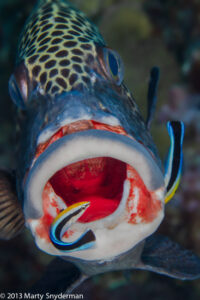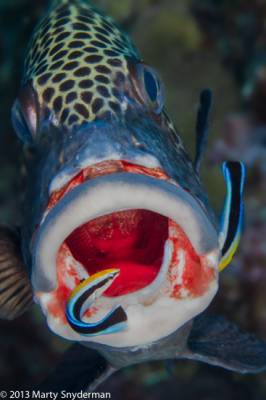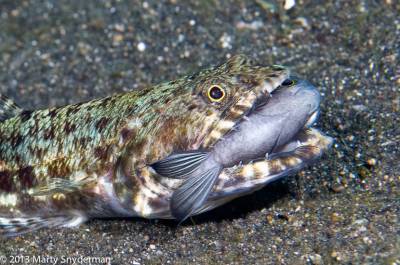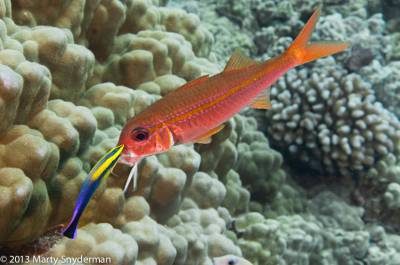
In an earlier blog I shared some thoughts about photographing fish. In that discussion I mentioned a number of categories that I use to help me get started creating pictures when I encounter a fish. I also stated that when I do not see a fish doing something such as courting, nesting, cleaning or anything else that I might classify as “behaviorally interesting”, I usually try to create an esthetically pleasing shot of that fish. And I might try to show the fish within the context of its environment. If you haven’t checked out that blog, you might want to take a look at what I had to say.
In the remainder of this piece I am going to share some things I do when trying to create “behavioral images”. Hopefully you will find these techniques beneficial to you as well.
So, for the purposes of this discussion, let’s assume I come across a many spotted sweetlips getting cleaned by a pair of bluestreak cleaner wrasse,

and I want to capture the moment. The first thing I do is stop so that I can assess the situation. At the same time I make sure I am neutrally buoyant. I don’t want to crash into the bottom and spook my subjects.
In this particular case, I know that if I try to barge right in and I get too close, I will likely disrupt the behavior. That would mean no photographs. So, given the size of my subjects and the lens on my camera, I try to figure out how close I need to get to the action to create an interesting shot.
Once I determine that rough distance I look at the lay of the land and try to determine where I need to go and how I need to move in order to get there without smacking into the bottom or any protruding reef.
Let’s assume I see where I want to position myself, and the way to get where I want to go. The next thing I do is adjust my camera settings to what I believe will be the correct settings, and I position my strobes. The idea here is to minimize my movements once I get in place.
Early on in my career I lost too many shots because I manipulated my camera controls or re-adjusted strobe arms once I was in position to shoot. That movement disrupted the behavior and spooked my subjects. In many of those instances I could have set my camera controls and positioned my strobe arms as desired before I got close to my subjects. Live and learn.
Assuming I get into position and have captured several frames, then, but only then, do I “check my results”. So, I look at my histogram and focus point on my LCD screen to verify my exposure and focus. If you are a relatively new shooter, you might only be looking at the image and trying to make a judgment about the quality of your shot. That’s okay. More experienced shooters often check histograms and focus, but that is not really the point I want to make here.
The point I want to emphasize is that very few of us can resist looking at our display to check our results. And if you are not careful, when you look at your display, you can make a mistake that will prevent you from improving your results with your next shot.
So, when looking at my display I am careful to back my head or body away from the camera as I hold the camera still so that I can easily see my display. I move myself back instead of pushing the camera out in front of me so I can review my results on the back of my camera. Push the camera out in front of me, and it gets closer to my subject. That seemingly little push will often disrupt behavior. So, back yourself up to check your results.
Once I have captured a few strong frames, I often see if I can get a little closer to the action. When it comes to behavioral images, I am often willing to start by shooting from a little farther away than I might ideally hope to, just to be sure I am able to capture the behavior. Once I get a better feel for the animals and their willingness to tolerate my presence, then I might try to get closer to my subject.
As an example, experience has taught me that it is often more difficult to get as close to a goatfish getting cleaned by a cleaner wrasse than it is to get close to sweetlips or a moray eel getting cleaned or to a lizardfish that has captured its prey.

In the case of a goatfish I will begin by shooting a little farther away than the place I hope to end up. In the case of the example photograph seen here, I was eventually able to get closer than my original shooting position.

In the case of the sweetlips and cleaner wrasse, it was very easy to get close to my subjects. But I was still careful not to get cavalier and make unnecessary movements that might disrupt the behavior.
Lastly, let’s now assume that you got a nice shot, or several nice shots. Instead of swimming away, take some more time to stop and watch. Quite often a behavior is a little different or more nuanced than I first anticipated. If you simply stop and watch, you might discover a better shooting angle or see an aspect of the behavior to photograph before you swim away.
We hope you find the information and images presented here helpful. And, we hope to see you back again on the 15th. If you did benefit from this blog, please tell a friend about it.
Thank you,
Marty Snyderman From the Vivid-Pix Gang
